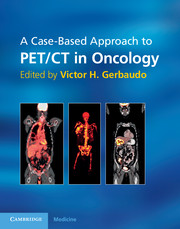Book contents
- Frontmatter
- Contents
- Contributors
- Foreword
- Preface
- Part I General concepts of PET and PET/CT imaging
- Part II Oncologic applications
- Chapter 5 Brain
- Chapter 6 Head, neck, and thyroid
- Chapter 7 Lung and pleura
- Chapter 8 Esophagus
- Chapter 9 Gastrointestinal tract
- Chapter 10 Pancreas and liver
- Chapter 11 Breast
- Chapter 12 Cervix, uterus, and ovary
- Chapter 13 Lymphoma
- Chapter 14 Melanoma
- Chapter 15 Bone
- Chapter 16 Pediatric oncology
- Chapter 17 Malignancy of unknown origin
- Chapter 18 Sarcoma
- Chapter 19 Methodological aspects of therapeutic response evaluation with FDG-PET
- Chapter 20 FDG-PET/CT-guided interventional procedures in oncologic diagnosis
- Index
- References
Chapter 14 - Melanoma
from Part II - Oncologic applications
Published online by Cambridge University Press: 05 September 2012
- Frontmatter
- Contents
- Contributors
- Foreword
- Preface
- Part I General concepts of PET and PET/CT imaging
- Part II Oncologic applications
- Chapter 5 Brain
- Chapter 6 Head, neck, and thyroid
- Chapter 7 Lung and pleura
- Chapter 8 Esophagus
- Chapter 9 Gastrointestinal tract
- Chapter 10 Pancreas and liver
- Chapter 11 Breast
- Chapter 12 Cervix, uterus, and ovary
- Chapter 13 Lymphoma
- Chapter 14 Melanoma
- Chapter 15 Bone
- Chapter 16 Pediatric oncology
- Chapter 17 Malignancy of unknown origin
- Chapter 18 Sarcoma
- Chapter 19 Methodological aspects of therapeutic response evaluation with FDG-PET
- Chapter 20 FDG-PET/CT-guided interventional procedures in oncologic diagnosis
- Index
- References
Summary
Introduction
Malignant melanoma, a neoplasm of melanocytes, has a lifetime risk of 1 per 75 people in North America, and accounts for only 5% of skin cancers, but is responsible for three times as many deaths as non-melanoma skin cancers (1). Both the incidence rate and mortality from the disease have increased significantly since the 1970s, though the former may be partly attributed to increased awareness and screening (2, 3). Melanoma is primarily a disease of white people; rates are up to 20 times higher in whites than in African Americans. Major risk factors apart from race include family history of melanoma, atypical or numerous nevi, sun sensitivity, a history of excessive UV exposure, immunosuppressed states, and occupational exposure to carcinogens (1).
Staging
Melanoma is staged using the widely accepted American Joint Committee on Cancer's (AJCC) TNM staging system, which was most recently updated in 2009 (4). This system defines stage by features of the primary tumor (T), the presence or absence of tumor spread to regional lymph nodes (N) and the presence or absence of metastasis to distant sites (M) (Table 14.1). The TNM classifications are then organized into anatomic stage groupings, which dictate prognosis, treatment options and are predictive of other expected features of the disease in a given patient (Table 14.2).
- Type
- Chapter
- Information
- A Case-Based Approach to PET/CT in Oncology , pp. 366 - 405Publisher: Cambridge University PressPrint publication year: 2012

